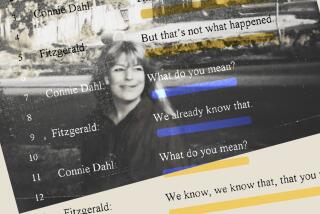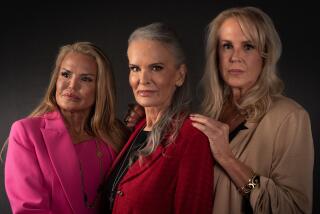Kaelin Bolsters, Frustrates Prosecution on Key Points
- Share via
Brian (Kato) Kaelin, whose testimony helps prosecutors establish their timeline for the June 12 murders of Nicole Brown Simpson and Ronald Lyle Goldman, fielded a barrage of pointed questions Thursday from the government’s lead lawyer, who suggested that he was shading his testimony out of loyalty to O.J. Simpson.
At the same time, however, Kaelin bolstered the prosecution’s case by testifying that he cannot account for Simpson’s whereabouts at the time authorities believe that the murders were committed.
Deputy Dist. Atty. Marcia Clark turned sharply on her own witness near the end of her questioning, scolding him about his unresponsive answers and attempting to emphasize his friendship with Simpson. As the day ended, Clark also suggested a new but unproven detail about a 1989 incident in which Simpson struck Nicole Simpson, asking Kaelin whether it was true that the Simpsons’ then-maid had opened a door during that fight so that Simpson could beat his wife.
Simpson, who has pleaded not guilty to the double homicide, recoiled visibly at that question, and his lawyers objected vigorously. After a long sidebar conference with Superior Court Judge Lance A. Ito, the judge directed jurors to ignore the question.
Clark’s questioning of Kaelin--at times coaxing and other times openly hostile--reflected the delicate, dual role that Simpson’s house guest plays in the case: His recollection of Simpson’s movements on the night of the murders suggests that the defendant was unaccounted for during a crucial hour and 10 minutes, but his description of Simpson’s demeanor that day and his testimony about the former football star’s relationship with his ex-wife tend to undercut the theory that Simpson was obsessively jealous and violent toward her.
Kaelin also helped prosecutors establish that there was blood in the foyer and driveway of Simpson’s home before he returned from Chicago and gave police a blood sample on the day after the murders. Kaelin testified that he saw blood drops early on the morning of June 13, about five hours before Simpson returned home--an observation that could undermine the defense’s contention that police used Simpson’s blood sample to stain items of evidence.
Under cross-examination, however, Kaelin said that in more than two years of living in close proximity to the Simpsons, he had never seen O.J. Simpson strike his ex-wife. Kaelin did add that he observed two incidents in which they yelled at one another.
As Simpson stared directly at him and members of Nicole Simpson’s family held hands in the audience, Kaelin described a 1993 incident in which police responded to an emergency call at Nicole Simpson’s house and found an agitated O.J. Simpson.
“Did you ever see any physical contact between them?” Simpson attorney Robert L. Shapiro asked.
“He didn’t hit her,” Kaelin responded. “There was no physical contact.”
That testimony may help the defense rebut the prosecution’s portrayal of Simpson as violently possessive of his ex-wife, but Kaelin’s testimony about the night of the murders helps the prosecution show that Simpson’s whereabouts cannot be accounted for during the time that authorities believe the murders were committed.
Kaelin testified that he returned from McDonald’s with Simpson about 9:35 p.m. and that the last time he saw Simpson, the defendant was facing in the direction of his house while Kaelin was heading back to his room near the pool.
*
The next time the two saw each other, Kaelin said, was just before 11 p.m., when Kaelin came out of his room to investigate three alarming thumps on his back wall and ran into Simpson in front of the house.
Clark concluded her questioning with a line of queries intended to emphasize that point.
“Did you see the defendant at 9:45?” Clark asked.
“No,” Kaelin responded.
“Did you know where he was at 9:45?”
“No,” he said.
The prosecutor repeated that same pair of questions for times all the way up to 10:50 p.m., getting the same answers each time. Clark then sat down, yielding the floor to Shapiro, who was far gentler with Kaelin even though he was a prosecution witness.
Kaelin, whose testimony often has been glib, did show one emotional moment Thursday when Shapiro asked him about the pain of losing a close friend to a murderer. Kaelin’s chin quivered slightly when Shapiro asked whether the past few months have been emotional ones.
“Yes,” Kaelin said softly.
“And you have done the best you can to try to recollect what took place, but you can’t be absolutely certain of everything you testified to, can you?” Shapiro then asked.
“No, I . . . I have been honest in everything I remember,” Kaelin said, his voice trembling slightly. “And I answered that way.”
Despite Kaelin’s protestations of honesty, Clark aggressively sought to show that he was shading some of his testimony to minimize Simpson’s guilt, particularly when it came to describing the relationship between O.J. and Nicole Simpson.
After Shapiro elicited statements from Kaelin saying that he never had any reason to believe that Simpson was jealous of his ex-wife dating other men, Clark vigorously challenged the witness’s credibility.
To make her point, Clark confronted Kaelin with a copy of his grand jury testimony and asked whether he had been questioned during that session about fights between O.J. and Nicole Simpson. Kaelin acknowledged that he had been asked about fights but had not related any.
But he also said that when Shapiro had asked him similar questions, Kaelin volunteered that he had been present at two loud arguments, both of which centered on men whom Nicole Simpson had dated. In the 1993 incident, Simpson yelled at his ex-wife about photographs of an old boyfriend, and during a separate Christmas Eve argument at the home of Olympian Bruce Jenner, the two had yelled at each other about old romantic interests, Kaelin testified.
Shapiro first raised the issue of those two arguments during his cross-examination of Kaelin, but Clark took full advantage when it was again her turn to question the witness.
Some observers criticized Shapiro for opening the door to that attack, which had the effect of reintroducing the topic of domestic abuse several weeks after the prosecution had left it.
*
“I think Shapiro made a mistake spending so much time in the spousal abuse area because it opened the door for Marcia Clark to go back into the 1993 . . . incident in a little more detail than had been previously testified to, as well as the Bruce Jenner Christmas party,” said Albert De Blanc Jr., a Los Angeles criminal defense lawyer. “So the jury heard more evidence about spousal abuse halfway through the prosecution case. It was a reminder of why O.J. might have hated Nicole enough to kill her.”
Given the opportunity to discuss spousal abuse, Clark asked Kaelin for many of the details of the two fights. He relayed them in disjointed fashion, but agreed that the altercations had been heated and that the topic, in both cases, had been anger about each other’s romantic interests.
For nearly three days, Kaelin has sat at center stage, his initial enthusiasm giving way to more somber testimony. During his testimony, Kaelin, an aspiring actor with a host of minor parts on his resume, has been ebullient, evasive and briefly grief-stricken--a startling contrast to the flat, unemotional testimony of the police officers who had preceded him.
At times, he seemed overwhelmed by the questioning, especially as Clark’s examination took on a harder edge.
On Thursday, the prosecutor appeared fed up with Kaelin’s cryptic answers to some questions, and she attempted to pin him down on the subject of why Simpson insisted that he not live under the same roof as Nicole Simpson. Clark suggested that Simpson was motivated by his need to control his ex-wife.
In January of last year, Kaelin had planned to move with Nicole Simpson to her new condominium on Bundy Drive, but she and Simpson were attempting a reconciliation at that point. According to Kaelin, Simpson persuaded him to live at his Rockingham Avenue estate instead.
“Did she feel you had betrayed her?” Clark asked Kaelin.
“No,” he responded. “She felt I was manipulated, was her words.”
As Clark bore down on that point, she tried to elicit Kaelin’s sense of why Simpson insisted that he not live with Nicole Simpson anymore. But Kaelin seemed to have difficulty grasping Clark’s questions, and their miscommunication frustrated both of them.
“What reason did the defendant give you?” she asked.
“Well, I mean,” he said. “I can, I don’t know.”
“You don’t know?” Clark asked, incredulous.
“I mean, it could have been, I don’t know,” Kaelin said, squirming uncomfortably in his chair and knitting his eyebrows under Clark’s stare. “But he didn’t say because you’re going to have, um, sex.”
After several more unsuccessful attempts to elicit a direct answer, Clark again asked Kaelin what Simpson had told him. “That it wasn’t right for me to be in the same house, a man in that same house with Nicole and the children,” he responded.
“And what did you take that to mean, Mr. Kaelin?” the prosecutor asked, relieved to be back on the point.
“That it could possibly have been he was thinking that I might be with Nicole,” he said haltingly.
“Sexually?” she asked.
“Possibly, that he was thinking that, yes,” Kaelin responded.
Kaelin’s recollections of some specifics were hazy, and each side sought to extract maximum advantage from his memory gaps. Shapiro honed in on Kaelin’s testimony that he could not recall seeing any cuts on Simpson’s hands when Simpson was preparing to leave for the airport on the night of June 12.
*
Prosecutors have said that Simpson was cut during a struggle with Goldman shortly before rushing home to meet an airport limousine, but Kaelin said he did not notice cuts on Simpson’s hand. Simpson told police that he might have cut his hand while searching for a cellular phone in his car that night, but the jury has not heard that statement.
Clark minimized the importance of Kaelin’s not noticing any cut, however, by eliciting his acknowledgment that he had not taken special note of Simpson’s hands at that time and thus could not be sure whether they were cut.
Kaelin was more definitive about seeing drops of blood in the foyer and driveway of Simpson’s house, testifying that police instructed him to avoid stepping on those drops as he left the estate on the morning after the killings--but before Simpson returned from Chicago.
Some analysts said those observations could strongly bolster the prosecution’s case.
“The prosecution,” said defense attorney and former police officer Barry Levin, “was blasting a major hole through the defense theory that this was a conspiracy by the police, because the police had not yet obtained Simpson’s blood.”
Even as the trial unfolds, the investigation into the June 12 murders continues, with authorities fielding a never-ending stream of tips and discoveries, many of which have proven to be dead-ends. The latest lead cropped up this week when Chicago police were alerted by a passerby to an Army camouflage jacket and a pair of sweat-pants near the hotel where Simpson stayed on the morning after the killings.
Thursday, however, police downplayed the significance of that discovery even as they confirmed that they were investigating it.
Capt. William Gartland, the commanding officer of the Los Angeles Police Department’s Robbery-Homicide Division, said that Chicago police had notified him about finding the clothes and that arrangements were being made to return the items to Los Angeles for testing.
Although the discovery generated considerable media interest, Gartland and other police in Chicago and Los Angeles were doubtful that the clothing will turn out to be connected to the Simpson case. More than nine months have passed since the murders, and police have searched extensively in both cities in vain attempts to locate bloody clothing or a murder weapon.
One police source said the clothing did not appear to be deteriorated enough to have been outdoors for such a long time. Gartland would not discuss the clothing’s condition, saying it had not yet arrived in Los Angeles. But he too expressed reservations about its significance.
“We are interested in that clothing, and we will examine it once it’s here,” Gartland said, adding however: “We’re skeptical.”
Times staff writer Henry Weinstein in Los Angeles and researcher John Beckham in Chicago contributed to this article.
More to Read
Sign up for Essential California
The most important California stories and recommendations in your inbox every morning.
You may occasionally receive promotional content from the Los Angeles Times.











